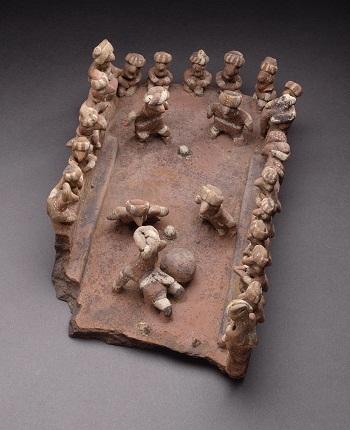It’s the week after Christmas, and you’d like to spend the day at LACMA with your kids. Overwhelmed by all the art options? Here are some suggested works that are usually a big hit with the younger crowd.
For the sports fan or aspiring soccer star
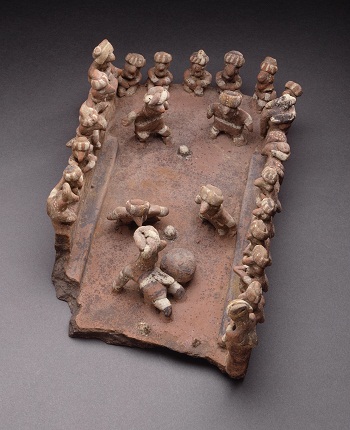
Ceremonial Ball Game, Mexico, Nayarit, 200 BC–AD 500, the Proctor Stafford Collection, purchased with funds provided by Mr. and Mrs. Allan C. Balch
This sculpture from ancient Mexico is a peek into the past and shows us that people have been playing sports for thousands of years! If you take a closer look, you and your kids will see some familiar sights: spot the players on the court, spectators on the side lines, and the all-important piece of equipment—the ball? The players are even wearing protective belts (see the white lines painted on their waists) and pads on their knees. Looks like a scene that you’d come across today, right?
Cool fact: The players hit the ball with their hips–never with their hands or feet!
Where to find it? Art of the Americas Building, Level 4
A fun work to look for color, shapes, and patterns
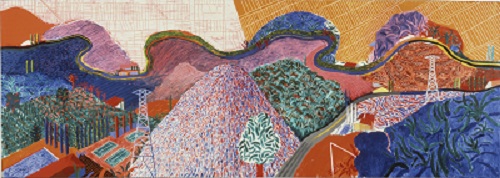
David Hockney, Mulholland Drive: The Road to the Studio, 1980, purchased with funds provided by the F. Patrick Burns Bequest
Los Angeles–based artist David Hockney was inspired by the commute from his home in the Hollywood Hills to his studio. Take a moment to look at the painting as a whole from a distance, and then walk closer to check out the details. See how Hockney reimagined everything he saw? Ask your kids to look for familiar objects such as swimming pools, trees, and houses. How are they different in real life? You and your family can also talk about different colors shapes, and patterns. Here’s an idea for a home project: Using colored pencils or crayons, make a Hockney-like drawing of your commute from home to school.
Cool fact: This painting is so heavy that it is almost impossible to move from its current location.
Where to find it? Art of the Americas Building, Level 3
A playful work of art that makes everyone feel small
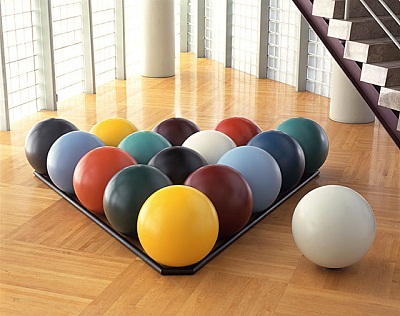
Claes Oldenburg, Giant Pool Balls, 1967, anonymous gift through the Contemporary Art Council
This sculpture of giant pool balls shows that art can be playful and whimsical. Each pool ball is two feet tall! How big would you have to be to play pool with these balls? Imagine how big the pool table would have to be! Claes Oldenburg had a comic vision of life and celebrated everyday life. There is no hidden meaning in the artwork—just sheer delight!
Cool fact: Los Angeles musician and artist Phranc says that seeing Giant Pool Balls at LACMA when she was a child made her want to be an artist.
Where to find it? Ahmanson Building, Level 2
A great work of art to visit after being inside the galleries
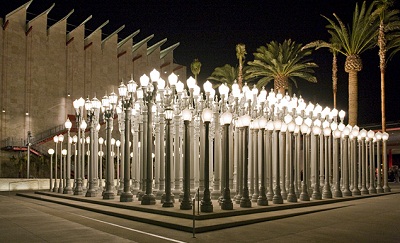
Chris Burden, Urban Light, 2008, The Gordon Family Foundation's gift to Transformation: The LACMA Campaign
Your kids will love how playful this forest of city street lights can be. It is the only work of art they can touch, and it has inspired many games of hide-and-seek and even processional marching. Encourage kids to take a close look at the ornate detailing on the bases and columns of the light posts. Take another moment to step back and notice how the lamps are organized. Another topic of conversation is the idea of collecting. Artist Chris Burden found his first street light at a swap meet. After he bought one, he just couldn’t stop! Who are the collectors in your family and what do they collect?
Cool fact: Urban Light is powered by solar panels on the roof of the museum.
Where to find it? LACMA’s BP Grand Entrance, visible day or night from Wilshire Boulevard
Not for the squeamish
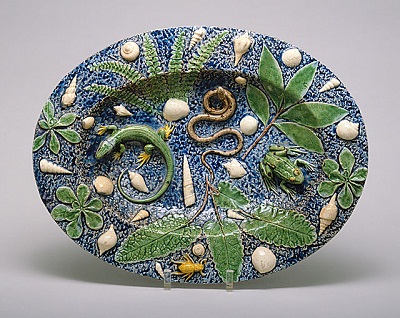
School of Bernard Palissy, Oval Rustic Dish with Shells and Reptiles, 1560–1600, purchased with funds provided by Mrs. Carl G. Riege in memory of her parents Mr. and Mrs. Julius Ziegert of Philadelphia, Guy Robertson Stewart Bequest, Mrs G. Rose, Mr. H.E. Rose, Mr. and Mrs. Harry D. Salinger, C.R. Sargent, W.H. Shilling and Mrs. R. Shuhart
Take a good look at this plate. What do you see? Some people might not think that lizards and slimy fish are good subjects of fine art, but French artist Bernard Palissy did! He combined his love of nature with his artistic talent to make a series of ceramic plates. If you were to make an artwork using images of animals, which ones would you include? Why?
Cool fact: The artist made molds of real bugs, frogs, and fish to create this plate!
Where to find it? Ahmanson Building, Level 3
More tips for a successful visit: Don’t try to see too much at a time. Keep the visit fresh and fun by exploring art inside, having a snack in the park, and seeing sculptures outside of the museum. Remember—with NexGen you and your child can come again, and again, and again. For free!
Alicia Vogl Saenz



